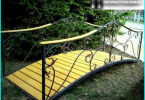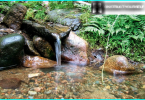
The first thing that meets us for garden gate garden path leading to the porch. From it in all directions: to the bath and to the garden and to the garage — run the same trails and paths. Always better to go for durable, well-groomed surface, especially when wet from rain, the grass or clay soil. Forget about designers and try to make garden paths with his hands, and for that we need only the desire and the construction material available, and cheap.
The contents
What are all of the garden path?
What classifications do not – and in material for manufacture, and location, and size. We take the division into types based on the way the device.
Garden trails
This is a natural view, as the paths appear by themselves, without special planning. They usually trodden by feet of men or compacted by the wheels of garden machinery and are used to connect critical points of area – houses, baths, garden, garden, gate. Normal dirt trail has disadvantages (dirt after a rain, puddles, overgrown with grass), so it is possible only as a temporary option. The trail, incidentally, is also possible to elevate enough to put on the edges of the border of cobblestones or paving slabs.
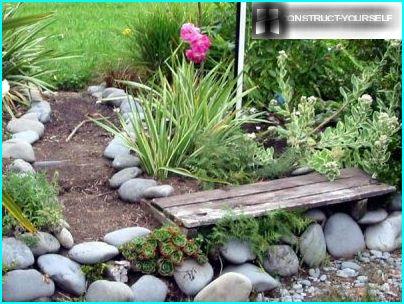
Garden trails — the best option for sites located in arid areas
Paths with a base of backfill
To do easy: it is necessary to dig a ditch, approximately 100 mm in depth, lay along the bottom and the edges of the geotextile (density not less than 150 g/m?), to strengthen the sides of the border tape. Will remain on the finished base to fill gravel, crushed stone, marble chips or screenings. If this option seems simple, you can optionally put on the surface of a stone or concrete slab – orderly or chaotic. For ease of movement of the plate should be drowned in the filling, so they were on the same level with the surface.
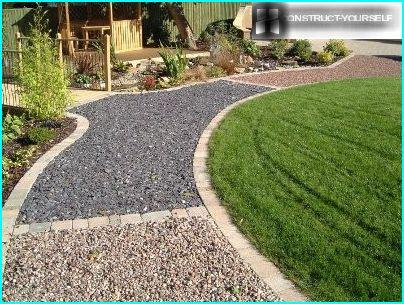
Choosing gravel or crushed stone of different colors, you can decorate paths or divide them into zones
Solid filler track
Durable coating ideal for heavy traffic. Paving garden paths occurs on a concrete base with further laying on his decorative elements: tile, paving stone blocks, natural stone. The use of material of different colors gives the decor a natural look. Better if the finished object will rise above the ground of 50 to 70 mm – this will save it from erosion water and soil sediment.
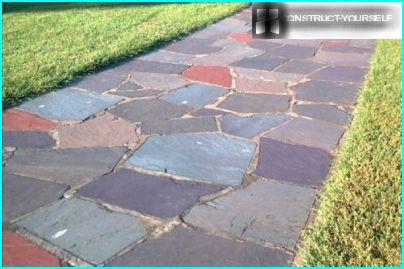
Track slab or stone laid on a concrete base and provide reliability and durability
The use of wood and saw cut bars
Budget and loved by the vacationers option – garden paths of wood. The most popular are two types:
- with the use of wooden bars;
- from wood cut down.
If the climate is rather dry than wet, you can use wooden bars or thick boards, which are easily purchased at any hardware store. It is better to stay on solid trees. Cut the segments are identical (length 100 cm, width 30 cm and a thickness of 15-20 cm) and placed on a prepared base of gravel or sand.
Each bar should be treated with oil or a special compound that protects against moisture and rot. With the same purpose in the underground part of the bar is applied the liquid asphalt, and the occasional sand standard pillow. Such combined coatings to the fact autumn, since in winter time the subsidence of the soil, which is made of natural compaction.
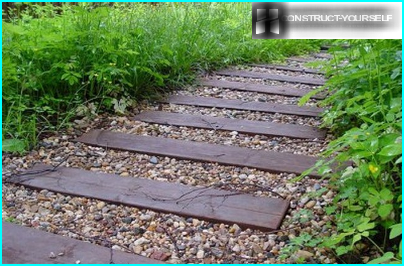
For tracks from wooden bruskov it is better to use gravel or crushed stone
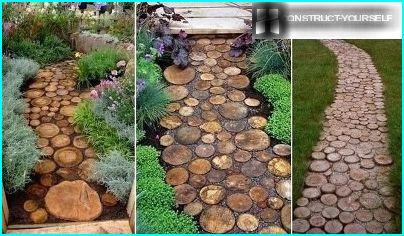
Using saw cut different size and color, you can create unique versions of the tracks
Old fallen trees at the cottage – a real find for people. Sawn trunks on the part of the elements – drunk – wooden sidewalks, which look equally good, crossing the lawn or winding among the flowerbeds. The course will not only trunks, but thick branches, cut down of which conveniently fill voids between larger elements.
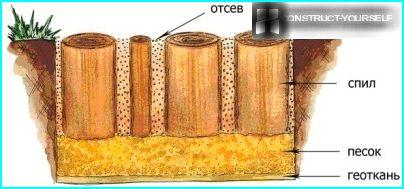
Screening strengthens the individual elements, and the geotextile protects the path from the grass
Order wood products were long, they need to treat all sides with hot linseed oil, it is better to repeat the procedure two times. Between the saw cut and the ground is put a piece of geotextile or polyethylene.
Brief master class on laying paving slabs
With the help of pictures and descriptions you can imagine how to make paths in the garden paving – material, noble and durable.
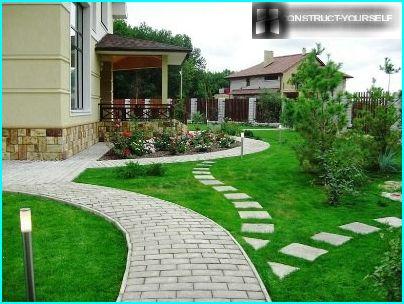
Track paving is irregular in shape look more natural than straight
To work need:
- wooden mallet;
- rubber hammer;
- stakes;
- trowel;
- building level;
- cord;
- rake;
- broom;
- garden hose;
- channel;
- manual compaction.
Materials: paving slabs (thickness of 50 mm or 60 mm), curb stone, crushed stone (fraction 20-50), dry mixture of plaster or cement M400 (M500), sand, geotextile.
Now consider all the stages of work. The first step is planning. It involves creating a drawing, the choice of laying pattern and shape of the shaped elements, choice of color (or multiple colors). At the same time make the calculation of the number of tiles (including the spare) and flow the rest of the material.
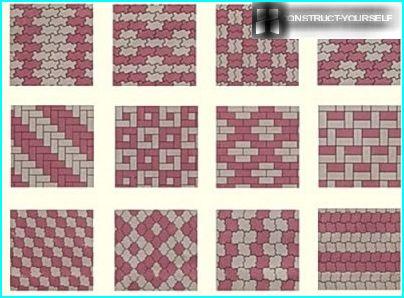
There are many schemes of paving based on the alternation of products with different colors
Next, execute the markup. Precision – one of the conditions for correct installation. Tape measure, pegs and string will help to define the boundaries of work. Sometimes you need to go on the intended path, to understand how its easier to build.
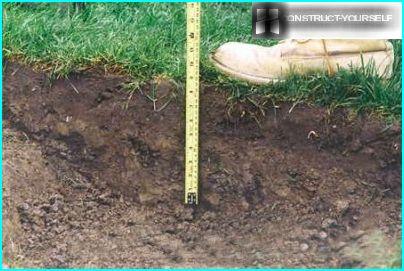
For the device tracks from paving slabs important to the accuracy of the marking and sequence of work
After marking, you must prepare the base. First we need to cut to a depth of 20 cm upper layer of turf. If the clay soil will help drainage. Then, create a sandy or gravel pad, and cement (concrete) screed.
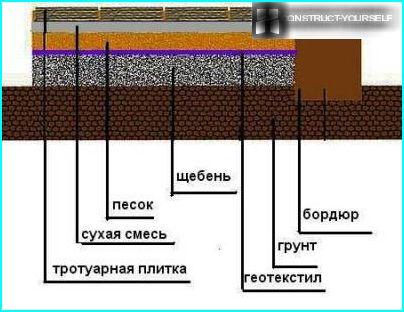
A multilayer substrate under the tile needed to track was solid, not settled and not eroded by water
Between the layers of sand and gravel to lay the geotextile, making the design more durable. The top layer is a dry mix, store-bought or self-made composition of sand and cement. A layer of mixture (3-4 cm) should be levelled with a rake and channel.
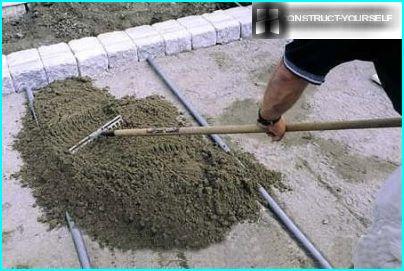
Uniform distribution of the cement mixture is produced using a normal garden rake
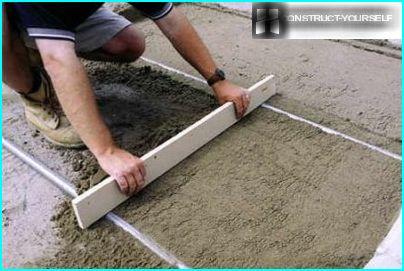
The channel for surface levelling can replace conventional wooden I-beam
Now hold the tile. The stacking direction – from themselves, not to ruin the base. Products must fit tightly but with a gap of 1-2 mm. Each tile should be compacted with wooden mallet. In the end, you should check with level and straighten with a rubber mallet. First, stack the whole elements, and only at the end of the cut paving slab and put the missing pieces.
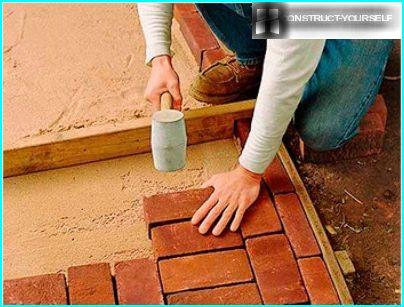
For quality paving required simple tools — a rubber mallet and a wooden mallet
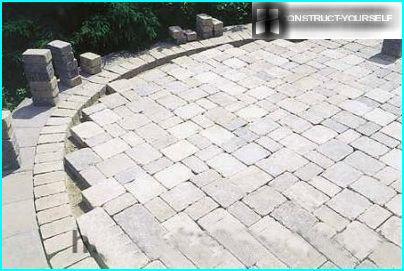
For ease of installation in the first place a whole product, leaving the edges of the void
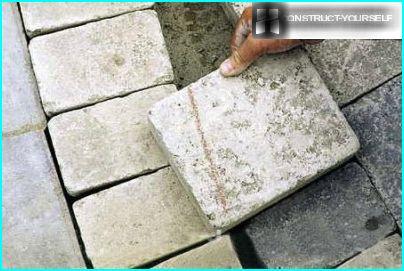
Emptiness along the border fill with pieces of tile required value
The edges of the post border, fixed with mortar M100 and filled with sand. The joints between the individual elements poured sand-cement mixture, which is then moistened with water from a hose. Add the mixture to the place where she sank, and repeat watering. After 2-3 days the track is finally ready.
The technology of mixing concrete slabs for walkways
Video instruction from 4-piece to work with the finished forms
Paths of natural stone: strength for the ages
Spectacular garden paths of stone can be made of material remaining after the construction of the house or garden decor, such as Alpine slides. The scenic trails created by the irregular shape and different size stones.
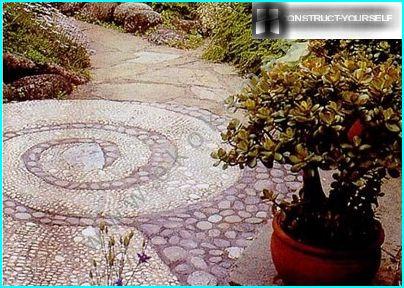
To create a beautiful walkway suitable stones of different sizes and colors
The first stage is the calculation of the number of large stones. To do this, they can be laid along the future trail. The reason for placing the pillow of sand, poured in a shallow ditch, directly into the soil.
Perhaps, for the joining of the stones will require treatment. Help grinder or a more serious tool. To place the material in two ways: in the form of a pattern (relief, mosaic), or in a chaotic manner, alternating between large rocks with smaller ones. If you do not score the joints between the stones with cement mixture, after some time they become overgrown with grass. This option is also possible, he looks more natural.
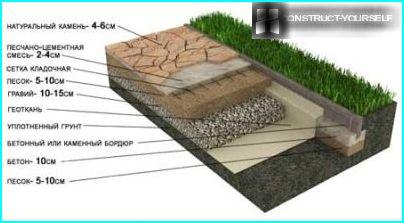
The diagram indicates the approximate thickness of each layer be followed during installation
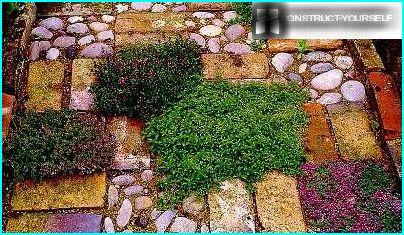
Combining different types of stone and plants — stripe pattern, suitable for the area in a Mediterranean style
Stone paths and walkways is appropriate when creating a landscape painting of any style.
Modern touch – the use of plastic modules
If there is no time for the construction of a solid stone or tile covering, but there is a desire to quickly establish paths in the garden with your hands, you can use temporary outdoor plastic track. Ready modules are usually equal in size and color, are sold in the store.
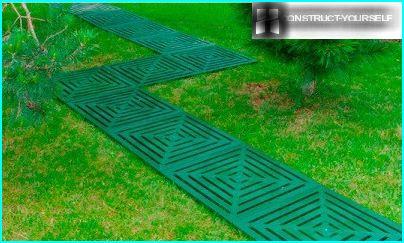
Color plastic modules is selected depending on the area they will be laid. Most often it is green or black products
In addition to low cost, paths, plastic, have other advantages:
- retain their shape and appearance for a long time, slowly wear out;
- have holes to ensure that water does not accumulate and left in the ground, i.e. do not form puddles, and don’t create smell;
- plastic practically does not rot;
- not require constant care and attention, a good clean and wash with water from a hose;
- resistant to chemical attack;
- quickly mounted and assembled on the principle of design;
- equally easy to fit to any base – sand, sod, clay.
At the end of the summer season modules, plastic, disassemble, wash, dry and put in the back room until next year.
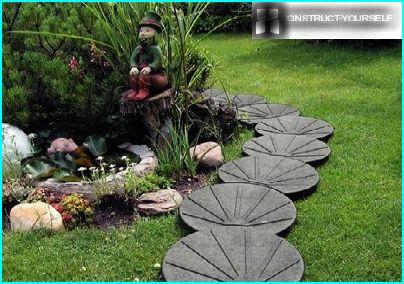
Plastic trails — a good option for creating temporary lanes on the lawns
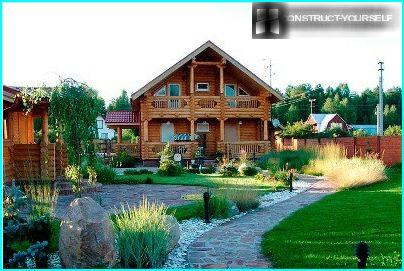
Track on the country site created not only for practical use but also for decorating site
Besides these options there are other types of garden paths brick, wood, concrete blocks, and various combination options. The basic rule of choice of material for the track: it must be combined texture and color with the house and other buildings.



